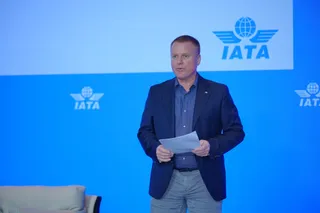Airbus – Training Together
Contact Our Team
For more information about how Halldale can add value to your marketing and promotional campaigns or to discuss event exhibitor and sponsorship opportunities, contact our team to find out more
The Americas -
holly.foster@halldale.com
Rest of World -
jeremy@halldale.com

Chris Long reports on issues discussed at the recent Airbus Training Symposium held in Dubai.
The task is already big – and getting bigger by the day. With over 60,000 pilots currently operating Airbus aircraft, and with that figure forecast to increase in line with the overall growth in civil aviation over the next 20 years (more than doubling the current fleet), there is clearly an expanding training task to meet the pilot demand. That scale of growth is inevitably multiplied in all the other disciplines associated with airline operations, from maintenance teams to dispatchers though to the customer interface, the cabin crews.
The over-arching theme at the recent Airbus Training Symposium in Dubai was that addressing such a huge task could only be accomplished by working together. That “together” embraces not just the manufacturer, but all the stakeholders in the industry, from the airlines themselves to regulators, through training equipment suppliers and the training organisations. The global view needs to encompass all the training that an industry professional would need throughout the span of his/her career, and in an ideal world the underlying principles and style of that training would be common across all the training footprints. A further consideration should be to recognise that not only must the content of the training be assessed against current and future skill sets required by increasingly complex operations, but that the training patterns must themselves adapt to the mindset, skills and potential of the new entrants into the industry.
Safety
The tie between safety and training has been the primary driver to recent changes to the organisational structure within Airbus. Historically, training has sometimes been seen as a peripheral activity, but its core role is now more obviously recognised in the fusion of responsibility for both training and operational support which reflects in Marc Parisis' new title, Vice President Training and Operational Support.
Parisis is determined that the oft-repeated mantra of “Safety is our First Priority” is a baseline for any discussion on operating commercial aircraft. The constant striving to improve safety is a given, and the industry can be forgiven for sometimes forgetting the enormous improvements which have been achieved. To put this into perspective, Yannick Malinge, Senior Vice President & Chief Product Safety Officer, pointed out that it is worth noting one of the many statistics on airline safety. For the first generation of jet aircraft the accident rate was @ 4.5 fatal accidents/million flight cycles. With the latest generation we are now at a rate of @ 0.1 fatal accidents/million flight cycles – a remarkable improvement (i.e. one fatal accident in 10,000,000 flights – compare that to any other transport system). It would appear that 2012 has the best civil aviation safety record for any year since 1945, despite being the busiest. That will be a challenging record to sustain, let alone beat, but it is very clearly the industry goal.
Many safety challenges have been successfully met with the introduction of new technology – perhaps the most obvious examples being EGPWS and TCAS. Further technical help is being introduced to help reduce accidents on the airport platform (runway excursions etc.), but overall there is increasing attention being drawn back to the human inputs, particularly in the area of the Human Machine Interface. Whilst careful system design can alleviate some of the difficulties, it has been observed that the supporting training needs to be equally robust.
So, with a much higher level of technical reliability already in place, and competent automated processes to help manage increasingly complex environments, the “low hanging fruit” for an incremental change in safety is to re-emphasise the importance of Human Factors. The proportion of inappropriate human inputs as a contributing factor in incidents/accidents has risen, largely because other causal factors have been reduced. Targeted training to address those human shortfalls is very much the present aim of training systems.
Networking
Parisis was very clear in his view that the role of Airbus is not to dictate what must be done, but rather to engage with the stakeholders and facilitate the debate on the future path of training. A couple of key drivers which help that discussion, and where the integration of ideas from the operators is essential, is firstly to use the immediate lessons from current operations to help define Evidence Based Training. This, coupled with the second driver, Competency Based Training, ensures that training is both immediately relevant to the daily task, and that crews in any discipline are both competent and confident to carry out their roles. This is in marked contrast to earlier models in which there was a lag in training requirements because of the necessity of having each element subject to specific regulation and legal process. Consequently there was a very slow feedback loop from the then current operation to effective modification of the training pattern.
Reinforcing the fundamental importance of the human in this pattern, Parisis was keen to point out the value of the networking opportunities throughout the three days of the symposium – not just in the conference hall, but in the less formal social opportunities which framed the overall event. These included an evening dining in the desert – an excellent chance to absorb some of the local culture and to mix freely with all the delegates. There is something intensely encouraging in seeing just how important direct human contact still is in cementing working relationships, even in this day of electronic exchanges.
Four Streams
In addition to the plenary sessions, which opened and closed the event, there were four focussed streams which addressed the interests of flight, cabin crew, maintenance and simulation and training technologies. Whilst there were topics specific to each stream, there was significant overlap across them, with presentations on the issues of the adoption of appropriate technology and ideas on the proper instructional methodology to address the natural learning style of the new entrants to the industry.
A common denominator was the frequent use of iPads or other tablets as the baseline tool for both instruction and operational use, reflecting a quasi-universal move to that technology within the industry. With such a platform the content and style of the transfer of knowledge has changed dramatically to reflect the approach to learning which is the current default setting for those leaving generic educational systems. That learning style is less formulaic and more engaging, and the material needs to be adapted, not in overall content – fundamental knowledge still needs to be there – but in the explorative and interactive presentation of the courses.
Probably the major shift in the training supplied by Airbus is not so much in the content – that has naturally evolved to follow the evolution of the established disciplines in civil aviation. The major change has rather been the addition of skills which were not hitherto the focus of the manufacturer. Flight crews may have to conduct non-revenue flights, when pilots can be called upon to operate post maintenance visit flights, or flights carried out after major repairs. Senior pilots can be called upon to conduct acceptance flights for used aircraft; all of these demand skills which are not used during normal line operation, and for which focussed training is now available in the Airbus training portfolio.
Conference Style
In keeping with trends in conference delivery, the presentations were deliberately staged to engage the delegates. For instance, not only were blogs encouraged during many of the presentations, (these drove the end-of-session Questions and Answers), but the value of active audience participation was evident. During a presentation on Assessing Pilot Performance, David Owens, Senior Director Flight Crew Development, showed a video of a notional simulator training session and asked the delegates to grade the event. Some 100+ senior instructor pilots were asked to assess the performance shown in that video. Naturally there was a statistically normal spread of scores, but what was encouraging was the high concentration of common scores – showing that there was a reassuring level of standardisation from a global range of training experts. Expertise was also available from other global players, like ICAO, the RAeS, as well as training organisations. Airlines, too, had the opportunity to pass on their experience and expertise – triggering the very exchanges and debates which were the aim of the conference.
Progress
Herbert Deiss, Head of Flight Crew Training, made it clear that Airbus has already moved to increase the delivery points for training – in addition to the six main Airbus Flight Training Centers in Toulouse, Miami, Burgess Hill, Beijing, Dubai and Delhi, the cooperation with CAE opens up a further 16. Each of these has plans for expansion so that training can now be delivered close to the customer.
For many years the idea of applying the Airbus “Golden Rules”, (based on the Aviate, Navigate, Communicate principles) to all Airbus aircraft has been at the centre of the Airbus philosophy. Aviation has never, and should never, stand still; new approaches constantly evolve and are applied. In the case of the “Golden Rules” it was judged time to take another look at them – and the result is a simplified set of 4 “Golden Rules for Pilots” (see photo). The core to that is still “Fly the Aeroplane!”
Alongside the new rules, there is a change of Airbus terminology to recognise a commonly-used categorisation – the pilot not flying the aircraft will from now on be referred to as the “Pilot Monitoring (PM)” to emphasise the active role which this duty requires.
Next Steps
The introduction of iPad technology and its use is being rolled out across the training specialities. For flight deck crews the iPad has now been approved as an EFB, so training support for that function is spreading to the airlines, as is the introduction of the iPad to the training and operation for cabin crews. The new A350 Flight Attendant Panel (FAP) uses compatible technology and operating philosophies.
There is continuous work in progress involving the in-depth study of the psychological triggers in training, and that is being fed into the courseware developers to ensure the most effective training tools reflect the present and future needs of the trainees.
A far-horizon view on training was explained by Michael Kalbow, Head of Airbus Maintenance Training; this neatly illustrated that, whilst the immediate training tasks are well understood, significant research is required to anticipate the training needs of the future.
There can be no doubt that the opportunity to update those responsible for the training tasks in the airlines is immensely valuable, not only for those already experienced in the role, but, importantly, for those newly promoted into their training organisations. The over 400 or so delegates at this Airbus Training Symposium recognised that to the full.

.png/r%5Bwidth%5D=320/7f2021f0-9a0d-11f0-b8f7-272ce5993c28-nano-banana-2025-09-24T11-07-03%20(1).webp)
